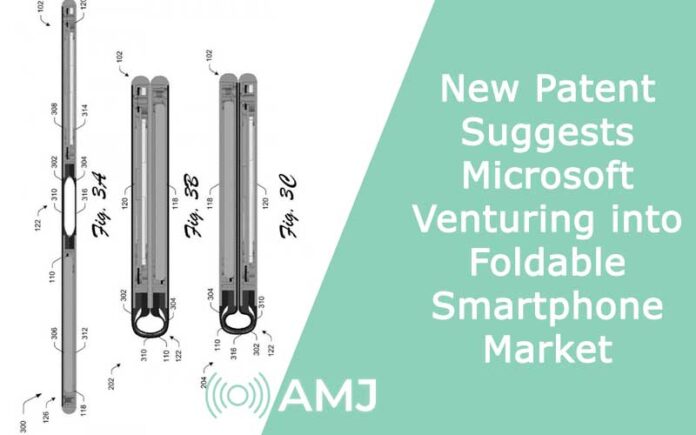A recent patent application hints at Microsoft’s potential entry into the foldable smartphone arena. The patent, published by the US Patent and Trademark Office on 29th February under the title “Foldable Computing Device Spine Cover Plate,” suggests a departure from Microsoft’s Surface Duo lineup towards a true foldable design.
The application, filed on 14th December 2022, describes a foldable device featuring a single foldable panel instead of two separate displays connected by a hinge, resembling Samsung’s Galaxy Z Fold series. One notable feature mentioned in the patent is the presence of a spine cover plate for the central hinge, similar to Samsung’s implementation.
While details about the device’s specifications are limited, the patent focuses on the hinge mechanism and the inclusion of a flexible display substrate. Illustrations accompanying the application strongly suggests the device is intended for use as a foldable smartphone.
The hinge mechanism described in the patent comprises movable hinges attached to the frame, complemented by multiple springs to ensure smooth closing and opening of the device. However, specifics regarding other features such as external design, internal specifications and camera setup remain undisclosed.
As per the patent, Microsoft is planning to design a hinge mechanism that will make the hinge crease on foldable smartphones less noticeable compared to current options on the market. The tech giant also outlined methods aimed at slimming down the overall thickness of foldable devices.
Microsoft proposes allowing the spine cover plate to move closer to the device’s hinge when folded will enhance the handling experience. They are focused on making the device easier and more comfortable, potentially enabling one-handed use.
The patent signals a potential shift in Microsoft’s product strategy, moving away from the dual-screen form factor of its Surface Duo lineup towards a more conventional foldable design. This aligns with previous reports suggesting Microsoft’s discontinuation of the Surface Duo series.
Despite the patent’s existence, uncertainties persist regarding Microsoft’s foldable smartphone. It remains unclear whether the device will feature a secondary display on the front or maintain a book-style design. Additionally, questions arise about the device’s form factor, with considerations for a slimmer body over a wider one.
It’s essential to note that while patents offer insights into a company’s research and development efforts, they do not guarantee the eventual release of a product. Therefore, whether Microsoft’s foldable smartphone will come to fruition remains to be seen.












![Index of Money Heist [Season 1, 2, 3 & 4 – All Episodes, Cast and Plot] Index of Money Heist](https://www.asiamediajournal.com/wp-content/uploads/2021/05/Index-of-Money-Heist-3-100x70.jpg)